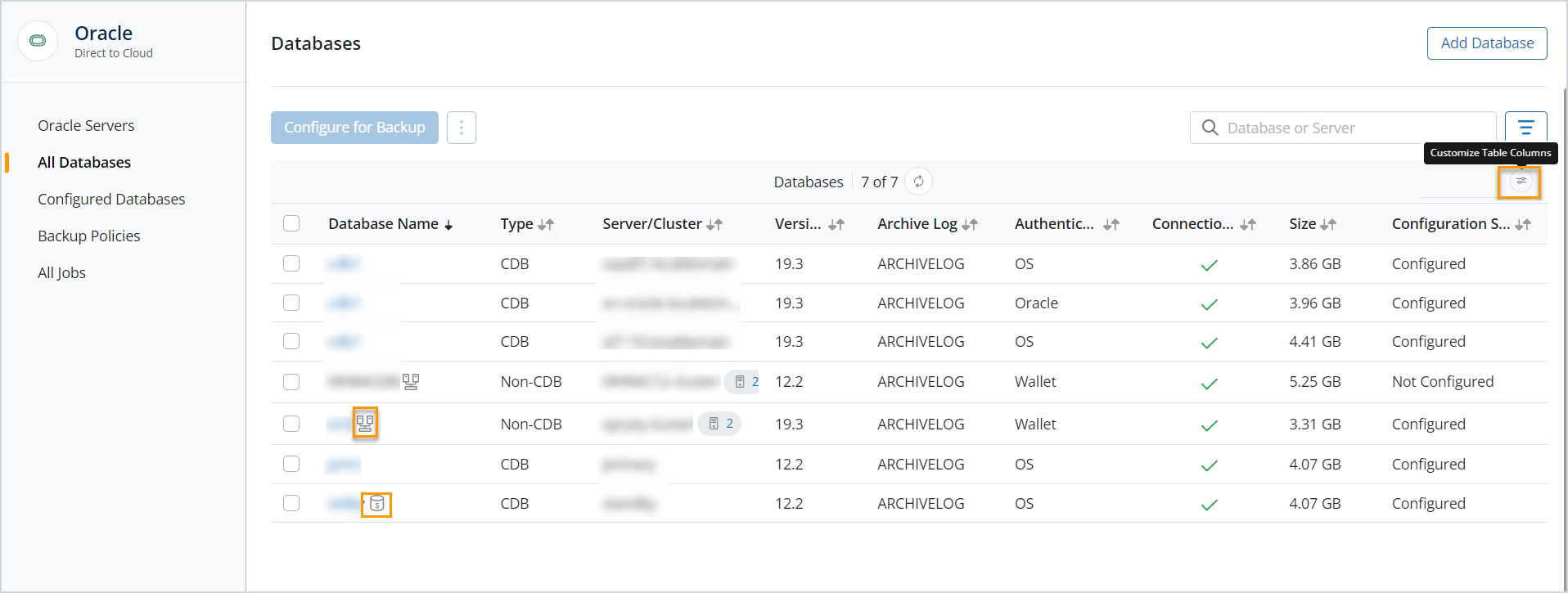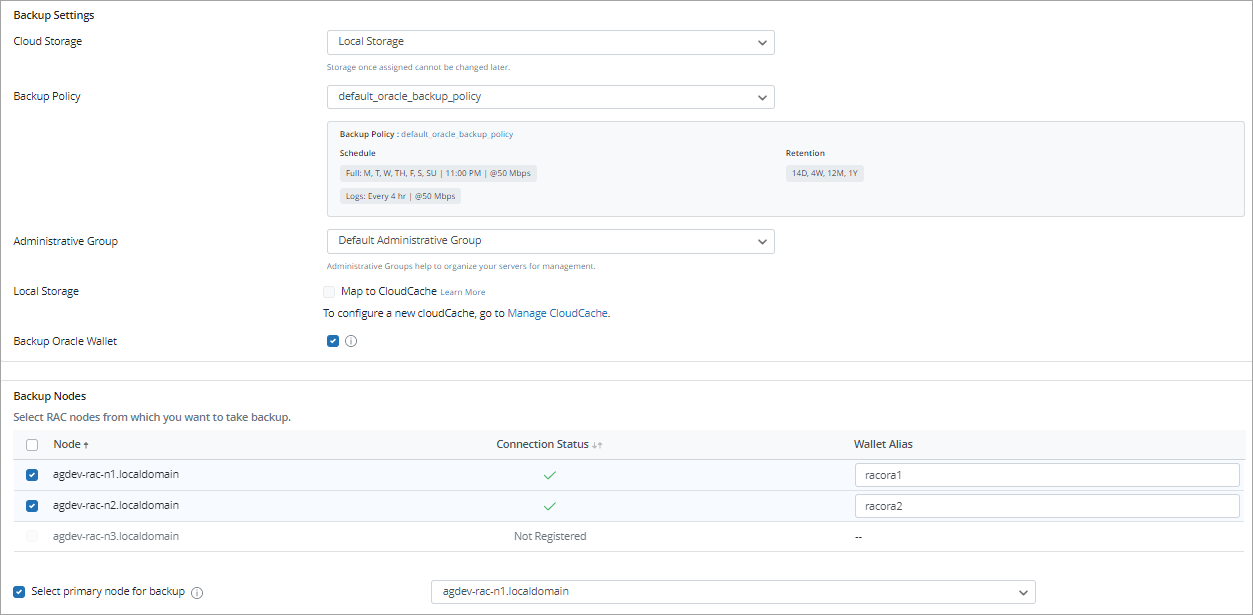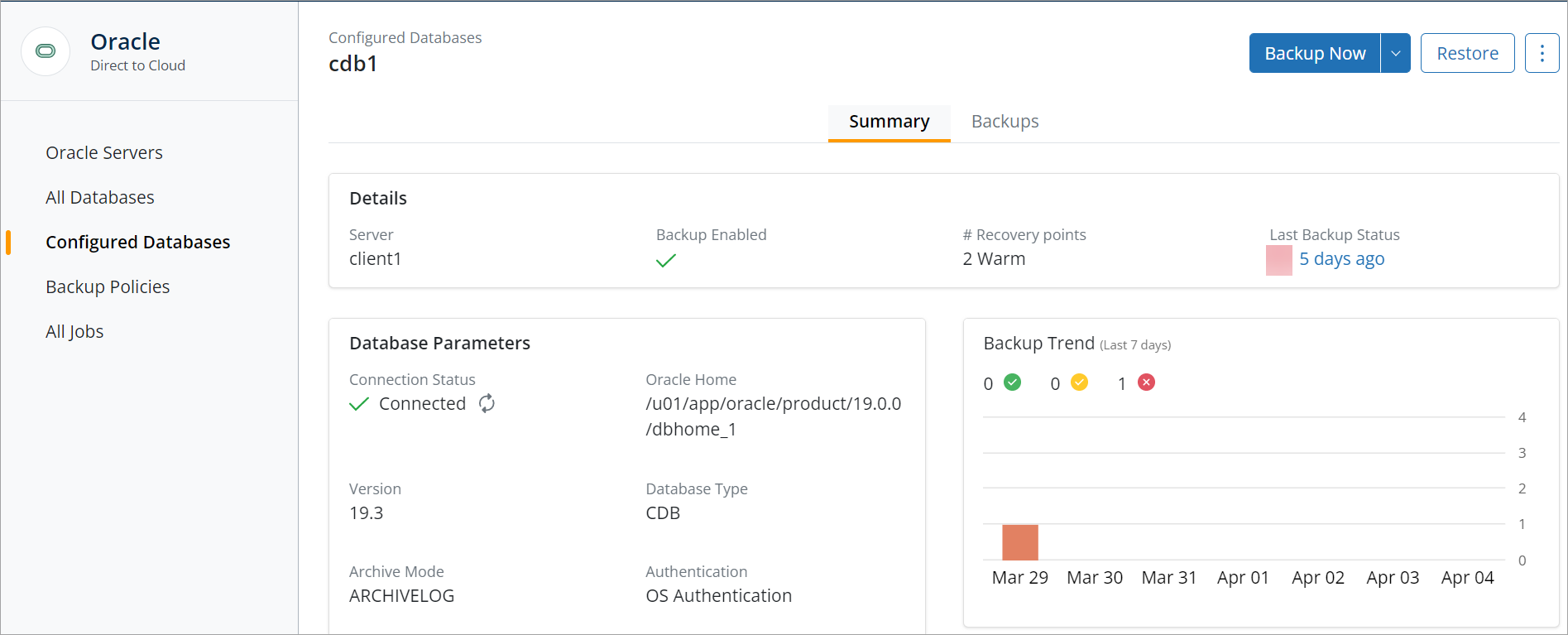Configure Oracle databases for backup
 Business
Business  Enterprise
Enterprise  Elite
Elite
The Hybrid Workloads agent discovers databases running on the registered server host and fetches their details on the Databases page. However, the discovered databases are not yet ready for backup. You must configure databases to protect their data in the Druva Cloud.
The following video illustrates the process.
Before you begin
Before configuring Oracle databases for backup, ensure that you read the following checklist:
- You are logged in as an administrator to the Oracle server host whose databases you want to back up.
- Your Oracle server matches the requirements listed in the prerequisites topic for the Oracle server.
- The All Databases tab lists the databases that you want to back up. If a database you want to back up is not automatically discovered, you can use the Add Database option on the Databases page to add a database for the registered server host. For more information, see Add a database.
- Ensure that the Hybrid Workloads agent is connected to the Druva Cloud for successful backup and recovery. See FAQs.
- Ensure you assign valid credentials and authentication types to the databases for successful backup and recovery. For more information, see Authenticate a database.
- Make sure that the database that you want to configure for backup does not have multiple standby configurations.
-
Ensure that the folder that you have configured for running RMAN scripts have execution permissions. The scripts are created in the /var/PhoenixOracle/scripts (for agent version 6.x or earlier) or /var/Druva/EnterpriseWorkloads/oracle/scripts/ (for agent version 7.x or later) folder by default. However, you can change this location by configuring the SCRIPTS_FILE_LOCATION property in the /etc/PhoenixOracle/Phoenix.yml (for agent version 6.x or earlier) or /etc/Druva/EnterpriseWorkloads/OraclePlugin.yml (for agent version 7.x or later) file.
-
Ensure the primary and standby databases do not share the same catalog. Backing up primary and standby databases that share the same catalog is not supported.
-
For the RAC databases, make sure that:
-
All the registered RAC nodes have the same agent version installed
-
The RAC node is in the Open state, and valid credentials are assigned.
-
Note: After upgrading, if the RAC database that you have selected for configuration is already configured as a standalone database, then the earlier backup set will be moved to the Deactivated state and you will no longer be able to configure that database as a standalone database.
Procedure
- Log in to the Management Console.
- Click Oracle > Direct to cloud from the Protect menu. Note that if the All Organizations menu is enabled, you have to first select an organization and then click Oracle > Direct to Cloud.
The Oracle Servers page opens. - In the left pane, click the All Databases tab.
The Databases page lists databases on the Oracle server hosts registered with Druva.
In the following screenshot, theicon represents a Standby database whereas the
icon represents a RAC database:

Additionally, you can click the Customize Table Columns icon to get a list of all the columns on the page:
- Select the checkbox to display the column.
- Clear the checkbox to hide a column on the Databases table. Removing unnecessary columns will make the UI more spacious.
- Move a column to change the order. The change is reflected in the Databases table.
The column configuration persists across sessions in the same browser.
Note: You can resize a column on the Databases table by dragging it to the desired location.

- In the Database SID column, select one or more databases, and click Configure for Backup.
Note: You cannot simultaneously configure multiple RAC databases or a RAC database with a standalone database.
- The Configure Oracle Databases page opens.

- The Database section lists the number and names of the database selected for configuration.
Note: Ensure that you have assigned credentials to the databases and verified that the connection status is successful.
- In the Backup Settings section, provide the following information:
Note: Only the files in the wallet root directory are backed up. The nested directories are not backed up.
- From the Cloud Storage drop-down list, select a storage region to store your backups.
Note: Storage once assigned cannot be changed later.
- From the Backup Policy drop-down list, select a pre-existing backup policy or create a new backup policy. If you select an existing policy, you can view the policy details by clicking View Details.
Note: You must have at least one policy with a FULL or Incremental schedule.
- From the Administrative Group drop-down list, select the required administrative group to logically categorize servers for better management. You can attach the databases to an existing administrative group or create a new administrative group.
Note: Druva provides the Default Administrative Group without any servers attached to the group.
-
Select the Local Storage check box to configure the database for backing up on the local storage that is configured as part of the CloudCache. For more information, see Configure CloudCache.
To configure database to backup on CloudCache, provide the following information:- CloudCache: Select the CloudCache you want to use. You must select a CloudCache that belongs to the same LAN.
- Retain backups for: Select the number of days you want to retain the backups in the local storage.
- The Backup Oracle Wallet checkbox is selected by default and is used to back up the auto-discovered wallet files for wallet-enabled databases. The backed up files can be restored later from recovery point or to a point in time.
-
In the Backup Nodes section, provide the following information:
Note: The Backup Nodes section is displayed only for the RAC databases.
-
Node: Select the nodes for backup. For a RAC database, if you have assigned OS authentication, make sure you select multiple nodes for failover support.
-
Alias: Provide the wallet alias to connect to the selected node. For the Oracle authentication type, provide the TNS alias.
-
Select primary node for backup: From the drop-down, select the node that you want to use as a primary node for backup. If you select only one node for backup, and if you select the Select primary node for backup checkbox, that node is automatically selected as the primary node.
-
- From the Cloud Storage drop-down list, select a storage region to store your backups.
- Click Save.
The configured databases now appear on the Configured Databases page. On this page, the configured stand by databases are represented by theicon and RAC databases are represented by the
icon as shown in the following screenshot:

When you configure a database, Druva triggers a backup job as per the schedule defined in its backup policy. You can also manually trigger a full or an incremental backup. For more information, see Manually back up a database.
Backup Oracle Wallet
If you have Transparent Data Encryption(TDE) enabled on your database, you may want to backup your wallet files. Because if TDE is enabled and the wallet files are lost, then even if the database is restored, the data won’t be decrypted. You can select the option to back up your wallet files while configuring the database for backup. For more information, see Configure Oracle server for backup.
If you choose to back up your wallet files, the auto-discovered wallet files for the wallet-enabled databases are backed up and can be restored from recovery point or to a point in time. If the wallet backup fails for any reason, all the wallet files are cleaned up from the recovery point and the job ends with the successful with errors status.
Note: Only the files in the wallet root directory are backed up. The nested directories are not backed up.
Next steps
Druva backs up configured databases automatically based on the schedule defined in the backup policy. If a restore is required, you can trigger it from the Management Console. For more information about restore jobs, see Restore Oracle Server Databases.
To view the configuration details, on the Configured Databases page, under the Database column, click the database whose details you want to see.

Additionally, you can also perform the following tasks:
-
Backup database(s)
-
Restore database(s)
-
Monitor jobs
-
View alerts

